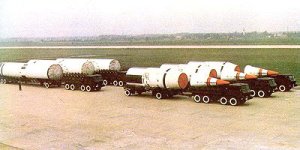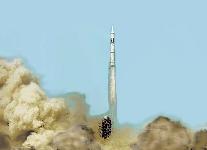





Development problems evidently precluded initial deployment of the DF-5 as an operational ICBM, but the space-launch version referred to by the Chinese as the FB-1 (Fengbao-Tempest) - was used as the booster for a series of five satellite shots that began in July 1975 and concluded in December 1976. The rocket uses four first-stage gimballed engines and one second-stage engine, all of which burn N2O4/UDMH. The Dongfeng-5 possessed the capability to hit targets in the western Soviet Union and the United States.
The absence of any space shots between January 1978 and September 1981 may well have related to DF-5 testing as China prepared for the long range testing of its experimental ICBM. Four partial range tests were reported in 1979: 7 January, 15 July, 21 August, and 4 September, and there might have been one in October. The final test shot was fired in February 1980.
By 1980 China had overcome the slowdown in nuclear development caused by the Cultural Revolution and had some spectacular successes in its strategic weapons program. Preparation for full-range tests base exercises at the Shuangchengzi site and ship exercises in the Yellow Sea began in March 1980. Finally, on 18 and 21 May, two long-range shots were made into the Pacific Ocean, where it was recovered by a naval task force. There seems to be agreement that the first shot was a success, traveling approximately 6,000 miles from the launch site to an area bounded by the Gilbert Islands, the Solomons, Fiji, and the New Hebrides, with splash-down occurring at 0230 Greenwich mean time. The second shot may well have been a failure, coming down perhaps 800 miles off course. When the DF-5 was first tested in September 1971, it had a range of 10,000 to 12,000 kms which allowed it to threaten the western portions of the United States. Beginning in 1983 the Chinese inaugurated the improved DF-5A, with an increased of over 13,000 km and a more accurate guidance system. The DF-5A upgrade increased the throw-weight of the system from 3,000 kg to 3,200 kg. As with the DF-4, initially the DF-5 was stored in a horizontal position in tunnels under high mountains, and are launched immediately outside the mouth of the tunnel. The missiles must be moved into the open and fueled prior to firing, an operational mode dubbed chu men fang pao (shooting a firecracker outside the front door), with the fueling operation apparently requiring about two hours. The initial deployment of a pair of DF-5s in silos in Central China was completed in 1981. That portion of the DF-5A force that is deployed in silos could be maintained in a ready-to-fire status. In order to enhance the survivability of these missiles, China has constructed a large number of decoy silos which consist of shallow holes excavations with headworks that resemble operational silos.For many years almost all sources credited China as having only four DF-5s deployed in silos, including the authoritative 1992 treatement by John Wilson Lewis and Hua Di, which asserted that as of 1992 only four DF-5 missiles on alert. However, more recent estimates suggest that some 8-11 were deployed as of 1995, and that at least 13 missiles were deployed at the end of 1997. According to the National Air Intelligence Center, as of 1998 the deployed DF-5 force consisted of "fewer than 25" missiles. As of early 1999 the total deployed DF-5 force was generally estimated at about 20 missiles. By mid-2000 some sources suggested that the total force was as many as 24 deployed missiles ["Inside The Ring" By Bill Gertz and Rowan Scarborough Washington Times July 28, 2000].
Although it is widely reported that the 5-megaton nuclear warheads for the DF-5/CSS-4 nuclear missiles are not "mated" to the missiles, but rather stored nearby, some sources suggest that US intelligence does not have a high confidence understanding of this question ["Inside The Ring" By Bill Gertz and Rowan Scarborough Washington Times July 28, 2000]. Although it might be assumed that the DF-5 deployment complex would include a nuclear weapons storage area, it is not evident that technical intelligence could identify signatures to determine the precise whereabouts of such a small number of nuclear weapons.
R&D on multiple independent reentry vehicles (MIRVs) was initiated as early as 1970. On 20 September 1981 China launched three scientific satellites into space orbit from a single booster, and many in the West mistakenly regarded this as indicating that China might possess the technology to develop multiple, independently targetable reentry vehicles (MIRVs). But the launch tested neither a MRV nor a MIRV, and indeed one of the three satellites was merely attached to the tail-deck of the second stage.
The current force of DF-5A missiles is deployed with single warhead, but in November 1983 China inaugurated a DF-5 modification program to arm these ICBMs with MIRVed warheads. Technical difficulties, however, have stalled the program. The DF-5A, able to strike targets in the continental United States (CONUS), was the designated recipient of the MIRVs, although there is no evidence that they have been deployed. Some sources claim that at least four DF-5As have already been MIRVed, though it is generally asserted that while MIRVing may occur within the next few years no DF-5s have yet been fitted with MIRVed warheads.
Based on the DF-5A throwweight and warhead shroud the missile could be equipped with a six reentry vehicles with each RV weighing 600 kgs (the size of the single warhead on the DF-21). The DF-5A second stage apparently has four vernier engines which reportedly fire for 190 seconds after the main missile engine cuts off. Thus the DF-5A could direct a warhead bus over a fairly large arc covering an array of aim points. But the exact status of this program cannot be confirmed based on open sources.
Specifications |
|
| Contractor | Chinese Academy of Launch Vehicle Technology - CALT |
| Operator | Second Artillery Corps |
| Basing |
|
| Configuration | Three Stages |
| Length [meters] | 32.6 |
| Diameter [meters] | 3.35 |
| Mass [kilograms] | 183,000 |
| Propellant | Storable liquid |
| Guidance | Inertial |
| First Flight | 1971 |
| IOC | 1981 |
| Deployment | Silo |
| Range (km) | 12,000 - 15,000 |
| Re-entry Vehicle Mass (kg) | 3,000 - 3,200 |
| Warhead Yield | 2 MT |
| CEP | 500 - 3,500 meters |
| Launch Preparation Time | 30-60 minutes |




